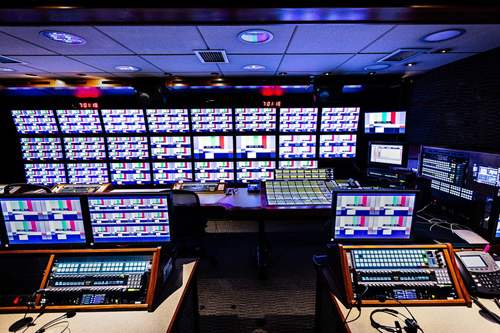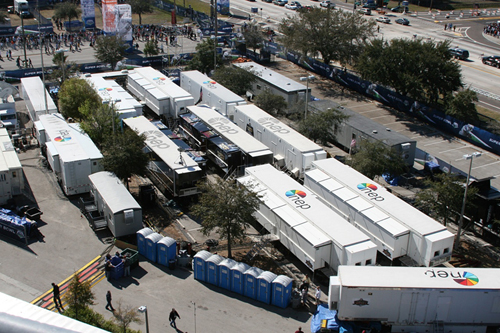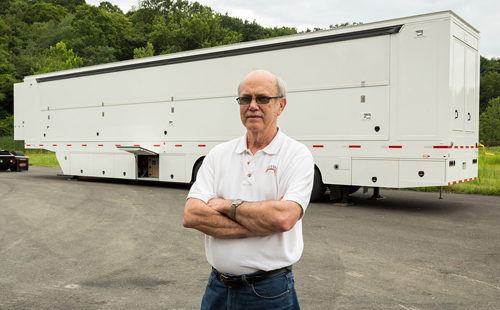Production Trucks: A Conversation with George Hoover

Interior of NEP Broadcast's EN1 production truck.PITTSBURGH ― As television viewers, we take coverage of large sports events for granted. Of course there should be great coverage, and our expectations are that it should be at least as good looking as other network programming―if not better.
George Hoover is a SMPTE Fellow and the chief technology officer for NEP Broadcasting, one of the largest remote production truck companies in the U.S. In the front lines of remote production at large events (such as weekly NFL football games), Hoover has seen an astonishing change in technology over the past 20 years and gets continual pressure from clients who want to distinguish their coverage from that done for other clients. At this level, technology change is continuous and there's often a "cost-be-damned" attitude to get it done.
BE Extra spoke with Hoover about the life of a well-equipped remote production truck at a big event such as an NFL game. What does it take to keep these big mobile control rooms rolling week after week, with trucks and crews seemingly in constant motion?
BE: It's my understanding that NEP has recently built new mobile units for several NFL broadcasters. What are a couple of the latest bits of interesting technology that you have in these trucks?
Hoover: GVG Kayenne Elite switchers, EVS XT3s, Sony 2500 cameras, Calrec Alpha or Artemis consoles.

An aerial view of NEP's production trucks at the 2009 Super Bowl.BE: When you roll up to a stadium or venue, how long does it typically take to get set up for the broadcast? What can be done at the venues to speed this up and make life simpler for you and the venue?
Hoover: That really varies on the complexity of the event and the venue. The primetime NFL games with 30-plus cameras and a crew of several hundred takes days. An NBA, NHL or MLB game on a regional sports network is typically a one-day set-shoot-strike. The biggest venue issues are logistics coordination: Is the space to park available when promised, electricians ready to power up when promised? That's really about all the venue itself is responsible for. Some are more user friendly than others; we all know the base ones.
Get the TV Tech Newsletter
The professional video industry's #1 source for news, trends and product and tech information. Sign up below.
BE: There's lots of talk about 4K cameras and production. How are you using 4K in your trucks? What additional 4K requirements are being considered for the future?
Hoover: 4K is used for specialty replay cameras allowing reframing. That is really the only use currently for sports. We do shoot live multi-camera 4K for some entertainment events that have 4K distribution.
BE: Can a truck that's used regularly for NFL football also handle other remote production needs? (Let's say that you need a truck for the Academy Awards, for example.) Do you have trucks for football and other trucks for other productions? Or is a well-equipped truck capable of handling any sort of remote production requirement?
Hoover: Our business is all about utilization, so an NFL truck can absolutely do other events. Many actually do mid-week NBA or NHL events in the fall and NFL on Sunday. Very high-end entertainment shows with a significant music or performance component use different trucks. Trucks are generally classified by the number of cameras they can handle―by volume most events are less than 10 manned cameras, so that is the sweet spot for most of the remote trucks
BE: What is the most important feature/consideration for a successful production truck? Cameras/lenses? Switcher? Monitor wall? Intercom? Servers? Why is that product/system the most important?

George Hoover, chief technology officer for NEP Broadcasting
Hoover: Actually the most important parts are the engineer-in-charge, the maintenance engineers and the drivers. Without them nothing much works. They need to be very client-savvy and have in-depth knowledge of how to operate and maintain all the aforementioned equipment. No one system is the most important―it is how the truck is designed and put together. Efficient, flexible, scalable and reliable is what we strive for.
BE: What else should BE Extra readers know about the life and times of a major remote production truck?
Hoover: Major remote trucks are very dependent on their humans to keep them well maintained, in top working condition. Lots of operational and logistical support is required from the home office along with good advance planning and communications from the production and technical teams.
Next time you watch a game, think about all the technology and manpower behind the scenes that make the broadcast look effortless. Consider also about how technological change is not just constant―it seems to accelerate every year. Keeping a fleet of well-equipped and -staffed production trucks on the road is not only a noteworthy feat, it's one that we all get to enjoy whenever we relax to watch a big game.
Bob Kovacs is the former Technology Editor for TV Tech and editor of Government Video. He is a long-time video engineer and writer, who now works as a video producer for a government agency. In 2020, Kovacs won several awards as the editor and co-producer of the short film "Rendezvous."

